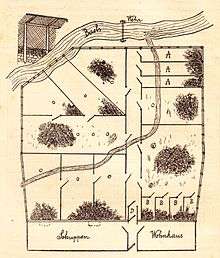Mink industry in Denmark
.jpg)
The mink industry is important to the economy of Denmark as the country is the largest producer of mink skins in the world, producing 40 percent of the world's pelts.[1] Ranked third in Denmark's agricultural export items of animal origin, fur and mink skins have a yearly export value of about EUR 0,5 billion. Kopenhagen Fur, located in Copenhagen, is the world's largest fur auction house; annually, it sells approximately 14 million Danish mink skins produced by 2,000 Danish fur farmers, and 7 million mink skins produced in other countries.[2] Mink produced in Denmark is considered to be the finest in the world and is ranked by grade, with the best being Saga Royal, followed by Saga, Quality 1, and Quality 2.[2][3]
History


Mink was introduced as a farm animal in Denmark in the mid-1920s.[4] By the mid-1980s, Denmark was the second largest mink producer, behind the United States.[5] In 1983, it produced 8.3 million pelts, amounting to 22 percent of world production, while in 2002, it produced 12.2 million pelts, representing nearly 40 percent of world production.[6] Fur trade has been declared as one of the twenty nine "special competence clusters in Danish economic life" by the Ministry of Commerce in Denmark.[7]
Farm production
Climatic conditions in Denmark, where the winter is mild and the summer is cool, are considered ideal for husbanding animals with fur cover.[8] Fish waste from the fishing industry is used as feed at mink farms.[9] A Danish mink farm might have 13,000 cages, set in rows of 60 metres (200 ft) length, and 43 sheds in which two to four minks are housed. Nesting boxes are attached inside the cage. Mink give birth to their litter of generally five offspring in the nesting boxes; they also feed the litter in the nesting boxes.[10] Using information technology, management, control, breeding and analysis can monitor genetic progress of the mink herd.[8]
Kopenhagen Fur serves as a farmers' cooperative. Concerted efforts of Kopenhagen Fur and Danish Animal Welfare Society (Dyrenes Beskyttelse), have optimized the environmental conditions for mink farming by developing rules, which received approval by the Ministry of Justice in 2007.[8] Danish fur farms produce about 15.6 million minks annually.[7] Though the country has some of the largest mink farms in the world, it also has many small business mink farms run by families.
Distribution

Mink fur of Denmark is exclusively auctioned through Kopenhagen Fur. Auctions are held five times in a year, with the first held in December after the newly pelted skins are ready, and the last in September. Each auction typically sells some 260 million euro worth of fur and lasts five days.[11] Major export markets for Danish mink are China, Hong Kong, Japan, and Korea. In the December 2012 auction, there were 500 bidders with 85 percent of the pelts purchased by customers from China. The average price per mink skin was 582 Danish crowns (US$100), the highest price ever recorded at Kopenhagen Fur.[12] Fashion house Birger Christensen, purveyor to the Danish royal family, is "the finest furrier in Copenhagen" and sells only Saga Royal grade fur.[3]
References
- ↑ Williams, Gill (2011). 100 Alien Invaders. Bradt Travel Guides. p. 38. ISBN 978-1-84162-359-7. Retrieved 11 June 2013.
- 1 2 "Mink and Fur". Danish Agriculture & Food Council. Retrieved 19 July 2013.
- 1 2 Sper, Sarah; Bluestone, Carissa, eds. (2006). Fodor's Denmark, 5th Ed. Fodor's Travel Publications. p. 61. ISBN 978-1-4000-1613-6.
- ↑ Long, John (2003). Introduced Mammals of the World: Their History, Distribution and Influence. Csiro Publishing. p. 281. ISBN 978-0-643-09916-6.
- ↑ Hohnen, David (1966). A Portrait of Denmark. Høst. p. 99.
- ↑ U.S. International Trade Commission (January 2004). Industry and Trade Summary: Furskins. Publication 3666. Washington, D.C.: DIANE Publishing. p. 19. ISBN 978-1-4578-2073-1.
- 1 2 "Facts". Kopenhagenfur.com. Retrieved 13 June 2013.
- 1 2 3 "The farm". Kopenhagen fur.com. Retrieved 13 June 2013.
- ↑ International Business Publications, USA (March 2008). Denmark Company Laws and Regulations Handbook. International Business Publications. p. 112. ISBN 978-1-4330-6971-0.
- ↑ Roth, Harald H.; Merz, Günter (1997). Wildlife Resources: A Global Account of Economic Use. Springer. p. 208. ISBN 978-3-540-61357-2. Retrieved 13 June 2013.
- ↑ "The largest fur auction in the world". Kopenhagenfur.com. Retrieved 13 June 2013.
- ↑ Fraende, Mette; Jensen, Teis (21 December 2012). "Danish mink industry toasts a Chinese chill". Reuters.com. Retrieved 19 July 2013.